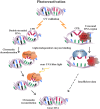DNA damage and repair in plants - from models to crops
- PMID: 26557130
- PMCID: PMC4617055
- DOI: 10.3389/fpls.2015.00885
DNA damage and repair in plants - from models to crops
Abstract
The genomic integrity of every organism is constantly challenged by endogenous and exogenous DNA-damaging factors. Mutagenic agents cause reduced stability of plant genome and have a deleterious effect on development, and in the case of crop species lead to yield reduction. It is crucial for all organisms, including plants, to develop efficient mechanisms for maintenance of the genome integrity. DNA repair processes have been characterized in bacterial, fungal, and mammalian model systems. The description of these processes in plants, in contrast, was initiated relatively recently and has been focused largely on the model plant Arabidopsis thaliana. Consequently, our knowledge about DNA repair in plant genomes - particularly in the genomes of crop plants - is by far more limited. However, the relatively small size of the Arabidopsis genome, its rapid life cycle and availability of various transformation methods make this species an attractive model for the study of eukaryotic DNA repair mechanisms and mutagenesis. Moreover, abnormalities in DNA repair which proved to be lethal for animal models are tolerated in plant genomes, although sensitivity to DNA damaging agents is retained. Due to the high conservation of DNA repair processes and factors mediating them among eukaryotes, genes and proteins that have been identified in model species may serve to identify homologous sequences in other species, including crop plants, in which these mechanisms are poorly understood. Crop breeding programs have provided remarkable advances in food quality and yield over the last century. Although the human population is predicted to "peak" by 2050, further advances in yield will be required to feed this population. Breeding requires genetic diversity. The biological impact of any mutagenic agent used for the creation of genetic diversity depends on the chemical nature of the induced lesions and on the efficiency and accuracy of their repair. More recent targeted mutagenesis procedures also depend on host repair processes, with different pathways yielding different products. Enhanced understanding of DNA repair processes in plants will inform and accelerate the engineering of crop genomes via both traditional and targeted approaches.
Keywords: Arabidopsis; DNA damage; DNA repair; crop plants; mutagenesis.
Figures




References
-
- Ahloowalia B. S., Maluszynski M., Nichterlein K. (2004). Global impact of mutation-derived varieties. Euphytica 135 187–204. 10.1023/B:EUPH.0000014914.85465.4f - DOI
Publication types
LinkOut - more resources
Full Text Sources
Other Literature Sources

